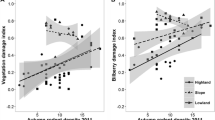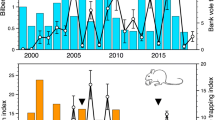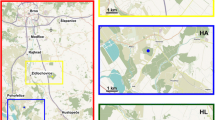Abstract
Variation in primary productivity has been described for an extensive range of natural systems and may lead to remarkable bottom-up effects on consumer communities at higher trophic levels. During a standardized sampling of the small mammal assemblage in the Reserva Florestal Morro Grande, SP, Brazil, we documented a bamboo blooming followed by an increase in abundance of small mammals. Here we described the effects of this blooming of the assemblage of small mammals and evaluated if (i) the abundance of frugi-/granivore species is affected more strongly than the abundance of insect-/omnivore species and (ii) due to the massive food availability in the habitat (bamboo seeds), body mass index of one of the affected species, the rodent Euryoryzomys russatus, will increase after the bamboo blooming. Although some species became more abundant, the difference was not related to species diet. We did find a significant increase in the body weight of Euryoryzomys russatus after the bamboo blooming. We emphasize that an infrequent and poorly known event like bamboo blooming can have a major impact on rodent population dynamics, regardless of the species diet, increasing abundance, and weight bottom-up controlled by the massive availability of food resources.



Similar content being viewed by others
References
Agrell J, Erlinge S, Nelson J, Sandell M (1992) Body weight and population dynamics: cyclic demography in a noncyclic population of the field vole (Microtus agrestis). Can J Zool 70:494–501
Anderson DR (2008) Model based inference in the life sciences. Springer. https://doi.org/10.1007/978-0-387-74075-1
Anderson WB, Wait DA, Stapp P (2008) Resources from another place and time: responses to pulses in a spatially subsidized system. Ecology 89:660–670
Areta JI, Cockle KL (2012) A theoretical framework for understanding the ecology and conservation of bamboo-specialist birds. J Ornithol 153:163–170
Banks-Leite C, Pardini R, Boscolo D, Cassano CR, Püttker T, Barros CS, Barlow J (2014) Assessing the utility of statistical adjustments for imperfect detection in tropical conservation science. J Appl Ecol 51:849–859. https://doi.org/10.1111/1365-2664.12272
Barros CS, Puttker T, Pinotti BT, Pardini R (2015) Determinants of capture-recapture success: an evaluation of trapping methods to estimate population and community parameters for Atlantic forest small mammals. Zoologia (Curitiba, Impresso) 32:334–344. https://doi.org/10.1590/S1984-46702015000500002
Barton K (2019) MuMIn: Multi-Model Inference. R package version 1.43.6. https://CRAN.R-project.org/package=MuMIn
Bergallo HG, Magnusson WE (2002) Effects of weather and food availability on the condition and growth of two species of rodents in southeastern Brazil. Mammalia 66:17–31. https://doi.org/10.1515/mamm.2002.66.1.17
Bonecker ST, Portugal LG, Costa-Neto SF, Gentile R (2009) A long term study of small mammal populations in a Brazilian agricultural landscape. Mamm Biol 74:469–479. https://doi.org/10.1016/j.mambio.2009.05.010
Bovendorp RS (2013) História natural e ecologia de duas espécies de roedores simpátricas da tribo Oryzomyini (Cricetidae: Sigmodontinae) na Floresta Atlântica., Escola Superior de Agricultura “Luiz de Queiroz”. Universidade de São Paulo
Bovendorp RS, Libardi GSE, Sarmento MM, Camargo PB, Percequillo AR (2017a) Age and habitat quality matters: isotopic variation of two sympatric species of rodents in Neotropical Forest. Hystrix 28. https://doi.org/10.4404/hystrix-28.2-12521
Bovendorp RS, McCleery RA, Galetti M (2017b) Optimising sampling methods for small mammal communities in Neotropical rainforests. Mammal Rev 47:148–158. https://doi.org/10.1111/mam.12088
Burnham KP, Anderson DR (2002) Model selection and multimodel inference. A practical information - theoretical approach. Spinger, New York
Camargo NF, Ribeiro JF, de Camargo AJA, Vieira EM (2014) Intra- and inter-individual variation show distinct trends as drivers of seasonal changes in the resource use of a neotropical marsupial. Biol J Linn Soc 111:737–747. https://doi.org/10.1111/bij.12258
Campos H (1986) Mamíferos Terrestres de Chile. Colección Naturaleza de Chile, Valdivia
Chauhan N, Saxena R (1986) Phenomenon of bamboo flowering and associated increase in rodent population in Mizoram. J Bombay Nat Hist Soc
de Vivar G (1987) De Crónica Y Relación Copiosa Y Verdadera de Los Reinos de Chile. Santiago, Chile
Delany M (1986) Ecology of small rodents in Africa. Mammal Rev 16:1–41
Delciellos AC, Aguieiras M, Geise L, Weksler M, Rocha-Barbosa O (2015) First record of Drymoreomys albimaculatus Percequillo, Weksler & Costa, 2011 (Rodentia, Cricetidae, Sigmodontinae) in Rio de Janeiro state, Brazil. Check List 11:1572
Díaz M, Alonso CL (2003) Wood mouse Apodemus sylvaticus winter food supply: density, condition, breeding, and parasites. Ecology 84:2680–2691
Douangboupha B, Aplin KP, Singleton GR (2003) Rodent outbreaks in the uplands of Laos: analysis of historical patterns and the identity of nuu khii. In: Singleton GR, Hinds LA, Krebs CJ, Spratt DM (eds) Rats, mice and people: rodent biology and management. ACIAR Monograph Series, Australian Centre for International Agricultural Research, Canberra, Australia, pp 103-111
Ernest SKM (2005) Body size, energy use, and community structure of small mammals. Ecology 86:1407–1413
Ernest SKM, Brown JH, Parmenter RR (2000) Rodents, plants, and precipitation: spatial and temporal dynamics of consumers and resources. Oikos 88:470–482. https://doi.org/10.1034/j.1600-0706.2000.880302.x
Ferraz DK (2004) Ecologia de populações de Lytocaryum hoehnei (Burret) Toledo (Arecaceae) na Reserva Florestal do Morro Grande, Cotia, SP. Doctorate, Universidade Estadual de campinas
Galetti M, Rodarte RR, Neves CL, Moreira M, Costa-Pereira R (2016) Trophic niche differentiation in rodents and marsupials revealed by stable isotopes. PLoS One 11:e0152494. https://doi.org/10.1371/journal.pone.0152494
Galiano D, Kubiak BB, Marinho JR, de Freitas TRO (2013) Population dynamics of Akodon montensis and Oligoryzomys nigripes in an Araucaria forest of southern Brazil. Mammalia 77:173–179. https://doi.org/10.1515/mammalia-2011-0128
Gallardo MH, Mercado CL (1999) Mast seeding of bamboo shrubs and mouse outbreaks in southern Chile. Mastozoola Neotrop 6:103–111
Gentile R, D'Andrea PS, Cerqueira R, Maroja LS (2000) Population dynamics and reproduction of marsupials and rodents in a Brazilian rural area: a five-year study. Stud Neotropical Fauna Environ 35:1–9
Gentile R, Finotti R, Rademaker V, Cerqueira R (2004) Population dynamics of four marsupials and its relation to resource production in the Atlantic forest in southeastern Brazil. Mammalia 68:109–119
Gilbert B, Krebs C (1981) Effects of extra food on Peromyscus and Clethrionomys populations in the southern Yukon. Oecologia 51:326–331
Giovannoni M, Vellozo LGC, Kubiak GVL (1946) Sobre as ‘ratadas’ do primeiro planalto paranaense. Braz Arch Biol Technol 1:185–1895
Guerreiro C (2014) Flowering cycles of woody bamboos native to southern South America. J Plant Res 127:307–313. https://doi.org/10.1007/s10265-013-0593-z
Guilherme FAG, Ressel K (2001) Biologia floral e sistema de reprodução de Merostachys riedeliana (Poaceae: Bambusoideae). Rev Bras Bot 24:205–2011. https://doi.org/10.1590/S0100-84042001000200011
Gunckel H (1948) La floración de la quila y del colihue en la Araucanía. Cienc Invest 4:91–95
Gurovich Y, Stannard HJ, Old JM (2015) The presence of the marsupial Dromiciops gliroides in Parque Nacional Los Alerces, Chubut, southern Argentina, after the synchronous maturation and flowering of native bamboo and subsequent rodent irruption. Rev Chil Hist Nat 88:17
Hershkovitz P (1962) Evolution of neotropical cricetine rodents (Muridae), with special reference to the Phyllotine group. Fieldiana Zool 46:1–524
Holmgren M, Stapp P, Dickman CR, Gracia C, Graham S, Gutiérrez JR, Hice C, Jaksic F, Kelt DA, Letnic M, Lima M, López BC, Meserve PL, Milstead WB, Polis GA, Previtali MA, Richter M, Sabaté S, Squeo FA (2006) Extreme climatic events shape arid and semiarid ecosystems. Front Ecol Environ 4:87–95
Holt RD (2008) Theoretical perspectives on resource pulses. Ecology 89:671–681
INPE INDPE (2020) Centro de previsão de tempo e estudos climáticos. http://satelite.cptec.inpe.br/home/index.jsp?i=br. 2020
Jaksic FM (2004) El Nino effects on avian ecology: lessons learned from the southeastern Pacific. Ornitol Neotrop 15:61–72
Jaksic FM, Lima M (2003) Myths and facts on ratadas: bamboo blooms, rainfall peaks and rodent outbreaks in South America. Austral Ecol 28:237–251
Janzen DH (1976) Why bamboos wait so long to flower. Annu Rev Ecol Syst vol 7:347–391
Kajin M, Cerqueira R, Vieira MV, Gentile R (2008) Nine-year demography of the black-eared opossum Didelphis aurita (Didelphimorphia : Didelphidae) using life tables. Rev Bras Zool 25:206–213
Keeley JE, Bond WJ (1999) Mast flowering and semelparity in bamboos: the bamboo fire cycle hypothesis. Am Nat 154:383–391
Koeppen W (1948) Climatologia: con un estudio de los climas de la tierra
Levi T, Kilpatrick AM, Barfield M, Holt RD, Mangel M, Wilmers CC (2015) Threshold levels of generalist predation determine consumer response to resource pulses. Oikos 124:1436–1443
Lima M, Julliard R, Stenseth NC, Jaksic FM (2001) Demographic dynamics of a neotropical small rodent (Phyllotis darwini): feedback structure, predation and climatic factors. J Anim Ecol 70:761–775
Lima M, Stenseth NC, Jaksic FM (2002a) Food web structure and climate effectson the dynamics of small mammals and owls in semi-arid Chile. Ecol Lett 5:273–284
Lima M, Stenseth NC, Jaksic FM (2002b) Population dynamics of a South American rodent: seasonal structure interacting with climate, density dependence and predator effects. Proc R Soc B Biol Sci 269:2579–2586. https://doi.org/10.1098/rspb.2002.2142
Loyola RD, Lemes P, Faleiro FV, Trindade-Filho J, Machado RB (2012) Severe loss of suitable climatic conditions for marsupial species in Brazil: challenges and opportunities for conservation. PLoS One 7:e46257. https://doi.org/10.1371/journal.pone.0046257
Mann G (1978) Los pequeños mamíferos de Chile (marsupiales, quirópteros, edentados y roedores). Gayana Zool:1–342
Martins EG, Araujo MS, Bonato V, dos Reis SF (2008) Sex and season affect individual-level diet variation in the neotropical marsupial Gracilinanus microtarsus (Didelphidae). Biotropica 40:132–135
Meserve PL, Milstead WB, Gutiérrez JR (2001) Results of a food addition experiment in a north-central Chile small mammal assemblage: evidence for the role of “bottom-up” factors. Oikos 94:548–556
Metzger JP et al (2006) Características ecológicas e implicações para a conservação da Reserva Florestal do Morro Grande. Biota Neotrop 6:1–13
Ministério do Meio Ambiente (2000) Avaliação e ações prioritárias para a conservação da biodiversidade da Mata Atlântica e Campos Sulinos. MMA/SBF, Brasília
Murúa R, González LA, González M, Jofré C (1996) Efectos del florecimiento del arbusto Chusquea quila Kunth (Poaceae) sobre la demografía de poblaciones de roedores de los bosques templados frios del sur Chileno. Bol Soce Biol Concepc 67:37–42
Myers N, Mittermeier RA, Mittermeier CG, da Fonseca GA, Kent J (2000) Biodiversity hotspots for conservation priorities. Nature 403:853–858. https://doi.org/10.1038/35002501
Numata M (1970) Conservational implications of bamboo flowering and death in Japan. Biol Conserv 2:227–229
Ojeda V, Chazarreta L (2018) Effects of episodic bamboo mast seeding on top predators in the southern Andes. Austral Ecol 43:719–729. https://doi.org/10.1111/aec.12618
Oliveira SVD, Folster I, Zeccer S, Fonseca L, Pereira SC, Caldas EPD (2014) Investigação de ratada associada a florescimento e frutificação de taquaras em São Francisco do Sul, Santa Catarina, Brasil, 2012. Revista Baiana de Saúde Pública 37:1071
Olmos F (1991) Observations on the behavior and population-dynamics of some Brazilian Atlantic forest rodents. Mammalia 55:555–565. https://doi.org/10.1515/mamm.1991.55.4.555
Olmos F (1996) Station or deception?: mast-seeding Chusquea bamboos, birds and rats in the Atlantic forest. Rev Bras Biol 56:391–401
Ostfeld RS, Keesing F (2000) Pulsed resources and community dynamics of consumers in terrestrial ecosystems. Trends Ecol Evol 15:232–237. https://doi.org/10.1016/S0169-5347(00)01862-0
Paglia AP et al (2012) Lista anotada dos mamiferos do Brasil / Annotated checklist of Brazilian mammals. Occas Pap Conserv Int 6:1–76
Pardini R, Umetsu F (2006) Pequenos mamíferos não-voadores da Reserva Florestal do Morro Grande: distribuição das espécies e da diversidade em uma área de Mata Atlântica. Biota Neotrop 6:1–22
Pardini R, Bueno Ade A, Gardner TA, Prado PI, Metzger JP (2010) Beyond the fragmentation threshold hypothesis: regime shifts in biodiversity across fragmented landscapes. PLoS One 5:e13666. https://doi.org/10.1371/journal.pone.0013666
Percequillo AR, Weksler M, Costa LP (2011) A new genus and species of rodent from the Brazilian Atlantic Forest (Rodentia: Cricetidae: Sigmodontinae: Oryzomyini), with comments on oryzomyine biogeography. Zool J Linnean Soc 161:357–390. https://doi.org/10.1111/j.1096-3642.2010.00643.x
Pereira C (1941) Sobre as “ratadas” no sul do Brasil e o ciclo vegetativo das taquaras. Arquivos do Instituto de Biologia de São Paulo 12:175–195
Philippi RA, Landbeck L (1858) Beschreibung einiger neuen chilenischen Mäuse. Archiv für Naturgeschichte 24:77–82
Pinotti BT, Naxara L, Pardini R (2011) Diet and food selection by small mammals in an old-growth Atlantic forest of south-eastern Brazil. Stud Neotropical Fauna Environ 46:1–9. https://doi.org/10.1080/01650521.2010.535250
Prevedello JA, Dickman CR, Vieira MV, Vieira EM (2013) Population responses of small mammals to food supply and predators: a global meta-analysis. J Anim Ecol 82:927–936. https://doi.org/10.1111/1365-2656.12072
Prevedello JA, Vieira MV, Vieira EM, Dickman CR (2017) The importance of food supply in high-productivity ecosystems: short-term experimental tests with small rodents. Austral Ecol 42:176–186
Quental TB, Fernandez FAD, Dias ATC, Rocha FS (2001) Population dynamics of the marsupial Micoureus demerarae in small fragments of Atlantic Coastal Forest in Brazil. J Trop Ecol 17:339–352
R Core Team (2019) R: a language and environment for statistical computing. Vienna, Austria: R Foundation for Statistical Computing. Retrived from http://www.R-project.org/
Rakotomanana R (1966) Peut-on prevoir les invasions de rats. Terre Malgache Tananarive 1:239–253
Redford KH, Eisenberg JF (1992) Mammals of the Neotropics. Vol. 2. The Southern Cone: Chile, Argentina, Uruguay, Paraguay. University Chicago Press, Chicago
Reichman O, Van De Graaff KM (1975) Association between ingestion of green vegetation and desert rodent reproduction. J Mammal 56:503–506
Sage RD, Pearson OP, Sanguinetti J, Pearson AK (2007) Ratada 2001: a rodent outbreak following the flowering of bamboo (Chusquea culeou) in southern Argentina. In: Kelt DA, Lessa EP, Patton JL, Salazar-Bravo J (eds) The quintessential naturalist: honoring the life and legacy of Oliver P. Pearson, vol 134. University of California Publications in Zoology, Berkeley - Los Angeles - London, pp 177-224
Schulte-Hostedde AI, Zinner B, Millar JS, Hickling GJ (2005) Restitution of mass–size residuals: validating body condition indices. Ecology 86:155–163
Seal SC, Ghosal SC, Bose PN (1951) Notes on the bamboo flowering, migration of rats and their unusual mortality in certain districts of North Assam. Calcutta J Med 48:149–155
Sikes RS (2016) Guidelines of the American Society of Mammalogists for the use of wild mammals in research and education. J Mammal 97:663–688. https://doi.org/10.1093/jmammal/gyw078
Singleton G, Belmain S, Brown P, Hardy B (2010) Rodent Outbreaks. Ecology and impacts, vol 1. International Rice Research Institute, Los Baños (Philippines)
Tanaka R (1956) Fluctuation in vole populations following the widespread synchronous flowering of bamboo-grasses on Mt. turugi. Bull Kochi Women’s Coll 4:61–68
Tanaka R (1957) An ecological review of small-mammal outbreaks with special reference to their association with the flowering of bamboo grasses. Bull Kochi Women’s Coll 5:20–30
Taylor K, Green M (1976) The influence of rainfall on diet and reproduction in four African rodent species. J Zool 180:367–389
Umetsu F, Naxara L, Pardini R (2006) Evaluating the efficiency of pitfall traps for sampling small mammals in the neotropics. J Mammal 87:757–765. https://doi.org/10.1644/05-Mamm-a-285r2.1
Venables W, Ripley B (2002) Modern applied statistics with S. statistics and computing, 4th edn. Springer, Verlag, New York. https://doi.org/10.1007/978-0-387-21706-2
Witmer G, Proulx G (2010) Rodent outbreaks in North America. Rodent outbreaks: ecology and impacts 253
Yang LH, Bastow JL, Spence KO, Wright AN (2008) What can we learn from resource pulses. Ecology 89:621–634
Young HS, McCauley DJ, Dirzo R, Goheen JR, Agwanda B, Brook C, Otárola-Castillo E, Ferguson AW, Kinyua SN, McDonough MM, Palmer TM, Pringle RM, Young TP, Helgen KM (2015) Context-dependent effects of large-wildlife declines on small-mammal communities in central Kenya. Ecol Appl 25:348–360. https://doi.org/10.1890/14-0995.1
Acknowledgments
We thank José Roberto Nali and SABESP for endorsing the research on Morro Grande Reserve. We thank T.K. Martins, T.R.D. Reis, N. da Câmara Pinheiro, M. Coelho, E.J. Feragi, G.S. Libardi, and all other field assistants for invaluable help during fieldwork. We are especially indebted to Dr. Teo Beckers for his comments and Renata Pardini and Thomas Püttker for allowing us to join their sampling effort on Morro Grande, for logistical and technical support, and for the careful and detailed reviews on earlier versions of the manuscript.
Funding
We are grateful to BMBF Germany (German Federal Ministry of Education and Research, 01 LB 0202), Conselho Nacional de Desenvolvimento Científico e Tecnológico (CNPq, productivity scholarship granted to ARP, 304156/2019-1), and Fundação de Amparo à Pesquisa do Estado de São Paulo - FAPESP (05/56555-4, 09/16009-1) for funding our research. RSB received Fellowship DD (2008/55483-8) BEPE (2011/121152-8) from FAPESP. NMH receive post-doctoral Fellowship from Coordenação de Aperfeiçoamento de Pessoal de Nível Superior (CAPES).
Author information
Authors and Affiliations
Corresponding author
Ethics declarations
Conflict of interests
The authors declare that they have no conflict of interest.
Additional information
Publisher’s note
Springer Nature remains neutral with regard to jurisdictional claims in published maps and institutional affiliations.
Electronic supplementary material
ESM 1
(DOCX 123 kb)
Rights and permissions
About this article
Cite this article
Bovendorp, R.S., Heming, N.M. & Percequillo, A.R. Bottom-up effect: a rodent outbreak following the bamboo blooming in a Neotropical rainforest. Mamm Res 65, 535–543 (2020). https://doi.org/10.1007/s13364-020-00505-y
Received:
Accepted:
Published:
Issue Date:
DOI: https://doi.org/10.1007/s13364-020-00505-y




